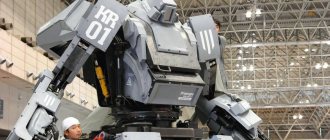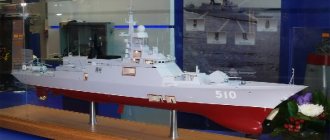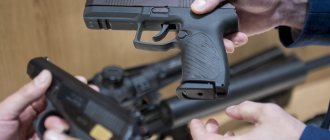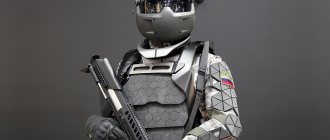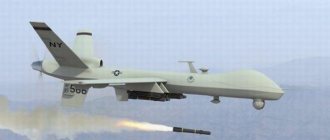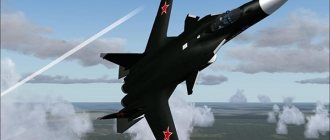MCX VIRTUS assault rifle (2015).
The SIG SAUER MCX VIRTUS assault rifle in 5.56 NATO and 300 BLK calibers represents the ideal modular platform and is designed to be a more adaptable, accurate rifle with a longer service life. The original SIG MCX rifle, created for special forces, quickly became famous in the world of firearms.
The MCX VIRTUS uses a proven piston system and a unique internal recoil system. To improve accuracy, the rifle uses thicker barrels and the new SIG Matchlite Duo two-stage trigger mechanism. The ambidextrous AR-style controls and folding, adjustable stock allow the weapon to be tailored to any shooter.
Nanorobot doctors
In 2010, the US military published a report that contained some interesting statistics. From 2001 to 2009, only 19% of evacuations from the Middle East were due to combat injuries. 56% of evacuations were due to disease. Historically, most military casualties are caused by disease rather than by the enemy. So DARPA began working on a solution: nanorobots that would live inside soldiers and diagnose diseases. Once a disease is detected, nanobots should ideally cure it before the soldier starts sneezing. A very useful military development. When it is adopted by the military, nanorobots will be able not only to prevent the spread of the disease, but also to save the military from chemical weapons.
AM17 Kalashnikov assault rifle (2016).
The small-sized AM-17 assault rifle of 5.45 mm caliber was created by specialists from the Kalashnikov concern as a compact and lightweight weapon for special forces. The result of this was to obtain the minimum possible size and weight. Length with folded stock 500 mm. Weight without magazine 2.5 kg. The receiver is made in the form of two receivers. The upper part, which experiences significant loads when firing, is made of steel. The lower unit of the box is made of plastic.
The automation operates on the basis of a gas engine with a short stroke of the piston. The machine has intuitive and convenient controls. The upper receiver features a Picatinny rail that runs the entire length of the receiver to accommodate any compatible scope.
Temperature resistance
Every person has a natural neurological receptor known as TRPM8, which is responsible for the feeling of cold.
When TRPM8 converts the physical feeling of cold into an electrical signal, it triggers the typical symptoms you experience in a cold environment: chills, chattering teeth, decreased blood flow to the extremities. These coping mechanisms are supposed to keep you warm, but sometimes they show up even in non-life-threatening situations. If you've ever tried to fire a pistol with your hands shaking, you'll understand how it hinders soldiers. However, in the future, trembling may no longer be a problem. A neuroscientist named David McKenney not only discovered the TRPM8 receptor, but also found a way to turn it off. What is the result? Your body simply doesn't feel the cold. As soon as the technology is tested on people, rest assured, genetically modified soldiers will appear.
H&K HK433 (2017).
The Hackler and Koch HK433 assault rifle is the Germans' long-awaited answer to the Belgian FN SCAR. HK433 is a modern modular system with small overall dimensions and low weight. The main caliber of the HK433 is 5.56x45mm NATO. The modularity of the rifle is given by 6 easily replaceable barrels of various lengths. Any optical, night or collimator sights and other related equipment can be installed on the top standard Picattini rail. A shot number sensor is built into the receiver.
The HK433 is designed to meet the increasingly complex small arms requirements of infantry and special operations forces. The special combination of materials and surface coatings used provides the weapon with minimal maintenance even under extreme operating conditions while maintaining high reliability and service life. The machine gun is made completely double-sided with a shutter lever that can be moved to a convenient side. Next is the fire mode switch with three positions: safety, single mode and automatic burst. The ergonomic buttstock folds to the right, is adjustable in length in 5 positions, and has a height-adjustable cheekpiece.
Bild: Superweapon of the future
The development of weapons and the development of new directions does not stop. Scientists and designers create fundamentally new types of weapons and equipment, and the public and the press follow their successes. Thus, the German publication Bild examined current projects that could have a significant impact on the further development of armies.
Bild published a series of articles devoted to superweapons from different eras. Journalist Niklas Renzel looked at different periods, including the present and the foreseeable future. The article “Unsichtbare Laser und Intelligente Kampfroboter: Die Superwaffen der Zukunft” (“Invisible laser and intelligent combat robot: superweapon of the future”), published on January 13, is devoted to promising systems for the next years, which are currently being developed and studied.
Like other articles in the series, the material on future systems is preceded by the aphorism of the British writer Martin Amis: “guns are like money - no one knows how much of it will be enough.”
Faster, higher, scarier. When it comes to developing weapons for war, the human mind has almost no limitations. At all times, certain armies had weapons that gave a serious advantage and did not leave the enemy a single chance. The publication Bild intends to consider superweapons from different eras, and in this article draws attention to samples of the future.
Scientists and engineers from different countries are already working on promising weapons systems, which are so far known only from science fiction books, films and computer games. Robots with artificial intelligence, invisible tanks and deadly lasers - science fiction may become reality sooner than expected.
Gauss cannons and rail guns
This weapon has a simple principle of operation and a completely uncomplicated design. For example, a rail gun contains only two guide rails to which voltage is applied. The resulting magnetic field accelerates the projectile along the rails. Both the rail gun and the Gauss gun, which has a different principle of ammunition acceleration, do not use a traditional type of propellant charge, characteristic of existing artillery.
The main advantage of such weapons is their high energy levels. According to N. Renzel, a rail gun differs from a traditional gunpowder gun in that it has four times the initial velocity of the projectile. This leads to an increase in the firing range and power of the ammunition. The gun does not require cartridges or cartridges with gunpowder, which saves space inside its carrier, such as a ship.
The main disadvantage is the highest energy consumption. To accelerate the projectile to the desired speeds, the gun needs an incredible amount of energy, which must be released instantly.
Weapons using electromagnetic projectile acceleration have been developed for more than a hundred years. The US Navy has been working on this topic since 2005. As part of the launched project, an Innovative Naval Prototype prototype was created, capable of sending a projectile to a range of up to 200 km. The developers believe that such weapons will “change the rules of the game” and will become a new unique weapon for warships.
However, rail guns are still inferior in their characteristics to a number of existing missiles. In addition, the main means of ship-to-ship combat will most likely remain corresponding missiles in the future. Nevertheless, promising electromagnetic systems are quite capable of replacing existing artillery, and therefore can count on the honorary title of superweapon.
Laser
Lasers are the quintessential science fiction weapon, bright, flashy and destructive. Naturally, the defense ministries of different countries are showing interest in such systems. For example, the British military department recently issued a new order for the development of a promising combat laser. The multi-million pound system is scheduled to be tested in two years.
Combat laser on the USS Ponce. US Navy Photo
John Nakuzi, a specialist at the American analytical center RAND Corporation, reminds us that lasers have been called the weapon of the future for the past several decades. At the same time, such systems reached testing at test sites a few years ago. For example, American armored personnel carriers were equipped with experimental combat lasers. For testing, the laser weapon was installed on the US Navy amphibious assault ship USS Ponce (AFSB-15).
The combat laser can affect the target in two ways. First, the laser beam transfers thermal energy to the target. Thus, one of the prototypes, when tested from a distance of 2 km, was able to burn through the body of a car and then destroy its engine. The second way to influence a target is to suppress optical-electronic systems with possible damage or destruction of devices. This could be used to combat unmanned aerial vehicles.
Laser weapon systems have two distinct operational advantages. They are of interest in the context of combating mortar shells or rockets used by terrorists. The laser weapon will be able to detect and hit such targets, melting their hulls and detonating the charge. The second advantage is the minimum cost of a shot. Missile weapons are very expensive: a missile can cost a million dollars. The laser gun itself is quite expensive, but each shot will cost only a few dollars.
Disguise
The enemy will not be able to hit the soldier if he does not see him. Current camouflage systems are based on different principles and deceive detection systems through their design or the materials used. Future camouflage will make entire military units literally invisible.
Scarlett Johansson as Major, a character from the film Ghost in the Shell who used active camouflage. Photo: Paramount Pictures
A means of camouflage that copies the environment and creates the impression of invisibility of a protected object is called active or thermo-optical camouflage. Moviegoers could recently see similar technology in the film “Ghost in the Shell.” Another example from fictional worlds is Harry Potter's magical invisibility cloak.
N. Renzel notes that active camouflage already exists. Moreover, real means of camouflage of this kind are not based on magic and are so far used only in the animal world. Examples are chameleons and some cephalopods. The following principles must be used in technical means of camouflage: the video system must capture the view of the object being covered and project it onto the front side of the latter. Thus, the observer will only see the background, while the protected object will remain unnoticed.
Force fields
Another invisible military weapon, this time impenetrable. Fantastic force fields in the future will be able to protect tanks, ships and aircraft from enemy fire. The military branch of Boeing has already studied this topic, and in 2015 filed an application for the first patent in this promising area.
Jessica Alba's character from the movie "Fantastic Four" uses a force field. Photo picture-alliance/ dpa
The proposed principle of object protection uses sensors and special protection systems. When an approaching weapon is detected, the automation must give a command to laser and microwave emitters. They will create a cloud of plasma in the path of the threat. This is a cloud in its temperature, density, etc. should be seriously different from the rest of space, because of which the flying projectile will encounter different loads and collapse.
Unlike the Star Trek spaceship defenses, such a force field could not be kept on all the time. Using it for a long time will cause excessive energy consumption.
Combat suits and exoskeletons
Thanks to its chitinous covering, the ant can carry a load 60 times heavier than itself. With exoskeletons, in the future people will also be able to work with heavy objects. The author of Bild notes that the direction of exoskeletons is no longer mere dreams of the future.
The use of an exoskeleton in rescue operations as imagined by artist Ken Chen
The Japanese University of Tsukuba recently introduced the Hybrid Assisitve Limb (HAL) exoskeleton. Using such a device, an ordinary person is able to carry a load that is five times the normal load. Exoskeletons of a special kind have already found application in medicine, where they are used for the rehabilitation of people with musculoskeletal disorders. Also, such equipment is of interest to heavy industry enterprises.
Naturally, exoskeletons have a great future in the military sphere. For example, Lockheed Martin created the Human Universal Load Carrier (HULC) system, which increases the physical capabilities of a soldier. Similar products have already reached the stage of testing and fine-tuning.
Robot soldiers
Combat robots, such as the Terminator from the film of the same name, have long been part of the horror genre. Meanwhile, armies of different countries are showing interest in such systems. According to the American newspaper New York Times, the Pentagon has invested $18 billion in the development of new combat robotic systems. As stated, the United States simply has no choice: strategic rivals Russia and China are developing their robotics, investing substantial sums in their own “sci-fi army.” Allies such as Israel and Great Britain are trying to keep up.
Humanoid combat robot T-800 from the film “Terminator 2: Judgment Day”. Photo by Studiocanal
In the arms race in the field of combat robots, the United States does not want to allow any threats to its status as the most powerful force on the planet. Moscow and Beijing have achieved impressive results in this area, their combat systems are almost as developed as the American ones. The Pentagon is beginning to talk about foreign developments almost with respect.
The advantages of automated combat vehicles are obvious. They are able to perform a task faster and more accurately than a human. In addition, they can go where no other person will go. At the same time, the robot operator, being at a distance from it, risks almost nothing.
For now, the Pentagon intends to make combat robots reliable partners of “human” units and make sure that they do not pose any threat to soldiers. At the first stage of the development of such equipment, American strategists intend to maintain a mixed army structure, including both people and equipment. Robots can take on the task of collecting data that will be given to people in the so-called format. augmented reality. Determining tactics and issuing commands, however, will still remain the tasks of humans, not artificial intelligence.
However, opponents of military robotics are not reassured by such plans. In 2015, several hundred scientists around the world signed an open letter criticizing robotic combat systems. The authors of the letter pointed out that even the simplest intelligent systems can provoke a new arms race, and in addition, there is a risk of such weapons falling into the hands of terrorists or rogue countries. The letter argued that autonomous systems would become the Kalashnikov of tomorrow - a simple, affordable and common lethal weapon. However, the US military department has already made a fundamental decision, and now the debate is on a different topic. American military leaders are trying to determine how much freedom can be given to automation and what decisions should be left to humans.
One example of the development of a future combat robot is the Atlas project from Boston Dynamics, created in collaboration with the DARPA Advanced Research Projects Agency. Recently, this robot, which does not yet have any military capabilities, showed its capabilities. He ran cross-country, fell but got up without difficulty, and then demonstrated his skills with a hockey stick.
Yu-71
One of the most important new products of the Russian army is the Yu-71 hypersonic aircraft, created as part of the project coded “4202”. According to N. Renzel, this product is capable of reaching speeds of up to 11,000 km/h and flying with a pilot or using remote control.
The greatest danger of the Yu-71 apparatus lies in the combination of speed and maneuverability. Conventional missile defense systems can only intercept a target flying along a predictable trajectory: by calculating the parameters of the latter, the missile defense system determines where to direct the missile defense. This technique is useless when protecting against trajectory-controlled aircraft. Due to its high speed, a hypersonic vehicle cannot be destroyed by existing types of air defense systems.
Yu-71 is an unmanned strike system: a guided, ultra-high-speed weapon with a nuclear warhead. As military experts reported, on February 26, 2015, Russia carried out the first launch of the Yu-71 experimental device.
The author reminds us that time is running out. In just a few years, the first Yu-71 will enter service. By 2025, Moscow wants to receive at least two dozen such devices.
Nanorobots
The prefix “nano-” comes from the Greek word for “dwarf.” One nanometer is a billionth of a meter. This is the size of the virus. N. Renzel asks: how do such microscopic particles relate to war? And he immediately answers that in the most direct way.
American physicist Louis del Monte last year presented a book about nanotechnology in the military sphere. The main conclusion of the book is that such technologies surpass even nuclear weapons in their destruction potential. According to the book Nanoweapons: A Growing Threat To Humanity, Russia and China are already investing billions in military nanotechnology.
Possible appearance of nanorobots of the future. Picture by Shutterstock/Lightspring
Due to their minimal size, nano-weapons will be able to operate unnoticed, and no one will be able to identify their identity. With its help it will be possible to hit manpower or destroy enemy resources, both military and civilian.
At a recent conference on global disasters held at Oxford University, experts identified the deadly potential of nanotechnology. Conference participants believe that nano-weapons are capable of destroying humanity before the end of the 21st century.
Artificial intelligence
For many years, scientists have been working on artificial intelligence systems. The goal of the work is simple - it is planned to create artificial systems capable of thinking and making their own decisions. However, we have to hope that these solutions will be useful for humans.
Officials deny the existence of fully autonomous combat systems. Drawing by Cybrain – Fotolia
Considering the problem of artificial intelligence, N. Renzel quotes businessman Elon Musk. He warned that such technologies are the most serious risk to civilization. J. Nakosi pointed out that there is a danger of losing control over weapons completely controlled by artificial intelligence. According to I. Musk, the final decision should still remain with the person. Otherwise, artificial intelligence may start a war involving fake news, fake emails, false press releases, and manipulation of information.
I. Musk also gives another example of artificial intelligence not working properly. The latter can redirect a passenger airliner into a conflict zone and give ground troops permission to attack. The prerequisites for this can be as simple as an attempt to make money on stocks while investing in defense enterprises. The businessman quoted in Bild believes that it is necessary to create laws regulating the development of artificial intelligence.
Researchers from the University of Würzburg studied the legal consequences of the use of artificial intelligence, namely the issue of liability for accidents caused by it. Professor Eric Hilgendorf believes that it is necessary to introduce full responsibility for the consequences of such accidents. The person who brought it to market must be responsible for the actions of the machine, even if his actions did not directly lead to the accident.
According to official data, fully autonomous weapons are not yet in use. However, according to rumors, a machine gun installation has already been deployed on the border of South Korea, independently searching for targets and “pulling the trigger.”
Spaceships and space stations
When people come somewhere, they bring war with them. Experts believe that the same will happen with outer space. The first attempts of this kind date back to the early eighties, when the United States launched the Strategic Defense Initiative program. The goal of this project was to create an orbital station with laser weapons. It was assumed that such a station, directly from space, would be able to destroy Soviet ballistic missiles before they became dangerous to the United States. However, the program was discontinued. She was too bold for her time, and besides, unacceptably expensive.
Real space battles are still far from those shown in Star Wars. Photo: Allstar/Lucasfilm/Walt Disney Pictures
A year ago, a new space command appeared in the structure of the American armed forces - US Air Force Space Command. Before its formation, the US Air Force command had 134 branches in different countries, employing 38 thousand people. The command budget was $9 billion.
The US Air Force Space Command does not have its own ships or battle stations. The purpose of this structure is to operate a global radar station. With the help of these objects, enemy missile launches should be detected. In addition, the command is responsible for the operation of a military satellite constellation, which includes devices for various purposes.
At the moment, as the author of Bild points out, humanity is far from full-fledged combat spaceships. However, since 2004, DARPA, in collaboration with Boeing, has been developing the X-37B aircraft project. According to known data, the second flight of this experimental machine, which began in 2011, was associated with the development of certain military technologies. In 2014, the third flight began, lasting a record 674 days. The purposes of such long flights were not disclosed.
Concluding the story about promising weapons for space, Niklas Renzel recalls the peculiarities of international law. Back in 1966, the Treaty on the Principles of the Activities of States in the Exploration and Use of Outer Space, Including the Moon and Other Celestial Bodies, was opened for signature. Among other things, this document regulated military activities in space. According to Article 4 of the Treaty, nuclear weapons or other weapons of mass destruction cannot be placed in Earth's orbit.
Article "Unsichtbare Laser und Intelligente Kampfroboter: Die Superwaffen der Zukunft": https://www.bild.de/bild-plus/news/ausland/waffen/die-super-waffen-der-zukunft-50557832.bild.html
IWI Carmel assault rifle (2019).
The prototype of the new modular assault rifle IWI Carmel, built according to the classical design, was first demonstrated by the Israeli company IWI in 2022. The receiver is made of aluminum alloy and partially enclosed in a plastic casing. The handguard, the trigger block with a pistol grip and the butt are made of impact-resistant reinforced polymer. All moving parts are contained in a solid aluminum rail with a hard anodized finish. All metal parts are made from special steels, aluminum parts are made from aviation grade aluminum.
The rifle is equipped with a classic gas-operated automatic mechanism with a rotating bolt and a short-stroke gas piston. Carmel is planned to be produced for a wide range of cartridges, such as: 5.56x45 mm, .300 BLK, 6.8 mm Remington SPC, 6.5 Creedmor (6.5x55), 7.62x51 mm and possibly even Soviet 7.62x39 mm.
Ultraviolet vision
In 2012, Dr. Miguel Nicolelis took a hammer to the glass box that contained everything we knew about the world and created a cybernetic mouse with a hypersensitive organ—and the ability to see in the ultraviolet spectrum. The neuroprosthesis developed by the scientist’s team consisted of two parts. The first was an ultraviolet sensor that was attached to the mouse's head like a hat. The second is a wire directly connected to the mouse's brain. More specifically, it connects to the somatosensory cortex, the part of the brain responsible for processing tactile sensations. When these two parts are connected, the mouse suddenly has the ability to "sense" the presence of ultraviolet light. It took about a month to explain to the mouse what this sensation was, but after thirty days the mouse was able to identify the source of ultraviolet light 90% of the time. Moreover, the mouse began to adapt to the new feeling. But a mouse is one thing, and people are completely different. In any case, Nicolelis plans to continue his experiments and one day reach people. The military applications of such technologies are priceless.
Zastava M90 assault rifle (2021).
At the beginning of 2022, the Serbian company Zastava Arms introduced a new clone of the AK-74M. The rifle is called PAP M90 PS and stands out in the family of Kalashnikov clones. In particular, the Serbs installed a three-position gas regulator on the weapon, as well as modern plastic accessories.
The gas regulator will allow you to better adapt the weapon to different types of ammunition. In addition, it will be useful when using silencers. The PAP M90 PS is also compatible with a number of additional accessories, which makes it easy to install a Picatinny rail, a protective casing, or return the look of the basic AK-74M. The PAP M90 PS will be produced in 5.56 NATO/.223 Rem.
Source - https://zen.yandex.ru/media/id/5df515cb1a860800aeada99e/5-perspektivnyh-avtomatov-na-blijaishee-buduscee-613219ef3df852715d22b23a
Luke's binoculars
Officially, this technology is called a “cognitive-technological threat detection system,” but even the guys from DARPA, who are developing it, are used to calling it “Luke’s binoculars.” It's still in development, so it doesn't even remotely resemble binoculars yet. What is this? Just a high-resolution camera mounted on a tripod and capable of seeing in the ultraviolet and normal spectrum for 10 kilometers without any interference. In addition, the system directly reads the EEG of the brain and, depending on the variations in the soldier's brain waves, identifies him as a threat. Our consciousness is capable of generating patterns of states, so the system bypasses the soldier’s thought process and directly reads the presence of a threat. The pattern is sent to the computer and signals: “This is a threat, shoot.” All this happens before the soldier himself analyzes what is visible, and then decides to attack or not. The difference is measured in milliseconds, but on the battlefield even milliseconds can make a difference. True, it remains to teach the computer to accurately determine where friends are and where enemies are.
Mirai no Torankusu no Ken
Alternative names
Brave Sword Sword of Trunks [1] Sword of Future Trunks [2]
Debut
Manga: "The Coming of the Cold King" Anime: "Mysterious Youth"
Users
Tapion Future Trunks / Trunks (unknown timeline) / Future Trunks (Cell Timeline) / Xeno Trunks Ki Co Android 14 Majin Ozotto [3] Xeno Gotenks Future Gohanks / Xeno Gohanks Saibamen [4] Future Warrior [5] Future Warrior [2] Captain Ginyu [2]
Class
Sword
Similar methods
Brave Sword Devil Blade Dimension Sword Gohan Sword Z Sword
Future Trunks Sword
(未来のトランクスの
Mirai no Torankusu no Ken
, ) is a powerful blade that Future Trunks carries with him from his first appearance in
Dragon Ball Z
until he is broken and apparently Android 18 is broken.
In Super
Future Trunks carries a new blade, which he uses throughout the "Future" Trunks saga.
This new blade plays a vital role in his final battle with Fused Zamasu, where he transforms into a great sword from the ki
he received from the remaining people of Earth.
Recommendations
- Dragon Ball Z Trading Card Game, 2000
- ↑ 2.0 2.1 2.2 Dragon Ball Xenoverse 2
, 2016 - Dragon Ball Z: VRVS
, 1994 - Dragon Ball Z: Battle of Dokkan
, 2015 - Dragon Ball Xenoverse, 2015
- Flashback in Dragon Ball Z
Episode 164, "Ghosts from Tomorrow" - Dragon Ball Z: Chest Story
, 1993
Forecasting war
It's one thing to respond to war with an array of weapons and technology, but what if you could predict every single shot? Lockheed Martin is developing a system that will do just that—predict wars in the same way meteorologists predict the weather (but hopefully more accurately). Since 2001, W-ICEWS has collected more than 30 million individual news clippings around the world. Using these data, a special iTRACE algorithm tracks military beacons in the world's media. In other words, the system looks for patterns in world news and determines which pattern indicates war. No one knows how effective this is.
CONTENT
- 1 Overview 1.1 Description
- 3.1 Manga and anime
3.3.1 Prison Planet Saga
- 4.1 Super Android 13
- 5.1 Plan to eradicate the Saiyans
Liquid metal rockets
Here's another new type of weapon that threatens to change the way we think about things blowing up. Traditional projectiles carry an explosive that detonates on impact and scatters metal debris. The new DARPA MAHEM (Magneto Hydrodynamic Explosive Munition) artillery takes a more elegant approach. Each warhead stores a magnetic generator that, upon impact, melts the metal shell of the core, which takes the form of a sharpened spear that better penetrates the armor it encounters. This technology allows for more accurate strikes with maximum lethality.
Smart uniform
When illness has nothing to do with it, there remains one more obvious disadvantage of war - gunshot wounds. For example, a quarter of combat casualties in Iraq from 2001 to 2011 could have been prevented if soldiers had received even more immediate medical care. In other words, people die on the way to the hospital. The military is working to solve this problem. It is not the construction of hospitals, but the development of uniforms that will help us survive. The unique uniform should send information about the injury to the nearest medical station. Sensors implanted into the tissue should record the location of the bullet, its depth and which vital organs were damaged. Other sensors will monitor blood flow and urine to detect other types of damage, chemical, nuclear or biological. The goal is to give the uniform the ability to identify any injury to a soldier.
Quantum camouflage
Optical camouflage—the patterns we use to decorate uniforms and vehicles to make them harder for the enemy to detect—has its limitations. They are designed to be similar in color and texture to their surroundings, but never blend perfectly into it. That's why many military engineers are developing "quantum camouflage," a high-tech cover system that will bend light around an object, making it invisible (after all, to see an object, you need to see the light reflected from it).
Gecko suit
When a gecko climbs a wall, it is held in place by tiny hairs on its feet.
The van der Waals force works - the gecko's legs hold onto the wall at the molecular level. The millions of microscopic hairs on a gecko's foot, called spatulas, create an electrical attraction with the molecules they touch. The force is so powerful that the gecko can hang upside down, clinging to the glass surface with just one finger. However, we can do this too. After studying geckos for years, scientists at the University of Massachusetts developed Geckskin, an artificial fabric that uses the same van der Waals force to adhere to surfaces. Geckskin is strong enough to support 317 kilograms on a small surface area. What military application could this have? Oddly enough, DARPA is directly involved in this project - its Z-Man program involves turning a soldier into something like Spider-Man.
